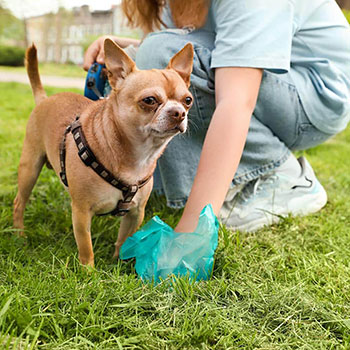Tapeworm Talk
Dr. Joel Ehrenzweig

It's not a pretty topic, but it's a conversation we need to have. Tapeworms. Not Dr. Debbie's favorite parasite (listen to find out what is her favorite!), but a nuisance none-the-less. Dr. Joel Ehrenzweig tells you how to identify and treat tapeworms. Did you know you can get 'em?
Year round, we need to make sure our pets are free of parasites, especially tapeworms. Pet owners spend $104 million a year to have veterinarians treat their pets for tapeworms, which affect about 25-percent of cats and dogs in the US.
With most worms, you are able to tell if your dog or cat has them by signs of vomiting or diarrhea. You can even see them in the stool. However, tapeworms are a lot sneakier. Rarely do they make your pet sick, but they do take 20-percent of what your pet eats. Sometimes you might even see egg-filled tapeworm segments, which resemble rice grains, sticking to fur under their tail or falling from your pet
Our pets get tapeworms from an intermediary host. Most pets get tapeworms from ingesting fleas. If your dog or cat has fleas, they have tapeworms! They can also pick them up if they hunt birds or rodents.
If your animal is a hunter, and they don't necessarily have to be a good one, Dr. Joel recommends routine de-worming. The medication for tapeworms is Droncit, which is a very, very safe product and has been around for many years.
ProLabs Tape Worm Tabs contain the exact same medication Droncit as vets use. They are are available over the counter and are an effective, less expensive, treatment for this parasite.
Should you be concerned giving Droncit if you're not sure your pet has tapeworms? No, if your pet doesn't have them, the medication will not harm them. However, if your pet had fleas last year or came home with a part of a rodent, there's a good chance they do have tapeworms and it would probably be better if you did de-worm them without knowing for sure.
Visit Website
It's Not Doggie Asthma - It's a Reverse Sneeze - Dr. Debbie
 What dog owner hasn't heard that frightening sound that dogs make - part cough, part sneeze and often described as a dog being unable to catch his breath. But it really isn't asthma, or some kind of bone stuck in your dog's throat - it's a reverse sneeze. So before you panic and run into the veterinary office on emergency, ensure you know what a reverse sneeze is.
What dog owner hasn't heard that frightening sound that dogs make - part cough, part sneeze and often described as a dog being unable to catch his breath. But it really isn't asthma, or some kind of bone stuck in your dog's throat - it's a reverse sneeze. So before you panic and run into the veterinary office on emergency, ensure you know what a reverse sneeze is.
Meet the Reverse Sneeze
A reverse sneeze is a respiratory sound in a category all its own. Also known as a pharyngeal gag reflex or backwards sneeze, the reverse sneeze is a commonly observed respiratory sound in dogs and less commonly in cats. While a true sneeze occurs on the exhale, the reverse sneeze occurs as the dog inhales. The result is a reverberating snorting, wheezing, episodic sound that lasts for a few seconds to a minute or two. A reverse sneeze is a completely harmless sound and dogs do not suffer any immediate health threat from these episodes.
How can you tell it's a reverse sneeze?
There is no easy explanation of the sound - you just have to hear it and you'll recognize it. Click to see and hear an example of a dog's reverse sneeze episode.
Part of my enjoyment on the weekly national radio program, Animal Radio, is describing the peculiar smells, sounds and essences of veterinary medicine with our listeners. On many an occasion when speaking to callers, I have re-created the sounds of reverse sneezing. I'm no Rich Little, but I do take pride in my impersonation of a canine reverse sneeze, which is admittedly better in person with the visuals to complement the throaty sound.
Characteristics of a dog displaying a reverse sneeze include:
- Vibrational coughing/wheezing sound
- Stiff, extended neck
- Facial grimace
- No discharge from nose
- Not followed by coughing or vomiting up material
- Not involving collapse episodes
- Animal is completely normal after event
 What causes a reverse sneeze?
What causes a reverse sneeze?
Some reverse sneeze episodes occur when a dog gets very excited or pulls against a leash. Brachycephalic breeds (short faced breeds) like Pugs and Boston terriers commonly display reverse sneezing due to their upper airway conformation.
Allergies, respiratory infections, nasal mites, inhaled foreign bodies and masses can also trigger reverse sneezing. Dogs with inflammatory conditions such as lymphoplasmacytic rhinitis can also display bouts of reverse sneezing. And sometimes reverse sneezing occurs in the wee hours of the night, while a dog is sleeping, for no apparent reason. In fact, many veterinarians receive panicked phone calls at 2am from pet owners, concerned of impending asthma attacks or respiratory arrest, only to have it turn out just to be a typical case of reverse sneezing.
What to Do?
There is no required treatment for a reverse sneeze episode. However, I recommend stroking a dog's throat while gently speaking to him in a calm manner until the episode subsides. Some advocate closing/pinching the nostrils off, which forces a dog to swallow and curtails the reverse sneeze episode. Whatever the approach, reverse sneezing episodes are over within minutes, so no emergency treatment is indicated. Antihistamines may be prescribed to minimize reverse sneezing episodes.
When to Worry?
If all of a sudden your dog is having repeated bouts of reverse sneezing, evaluation by your veterinarian is indicated. Consult with your veterinarian if your dog is reverse sneezing along with other symptoms such as facial rubbing, nasal bleeding, nasal discharge, coughing, or significant sneezing episodes.
Nasal mites are a common cause of reverse sneezing and may be noted after a recent boarding visit, especially if multiple dogs in a household are involved. Nasal mite treatment is easily pursued with anti-parasite injections of ivermectin (or in collie breeds - the alternative Milbemycin.) If reverse sneezing is excessive and prolonged, the nasal and pharyngeal areas should be evaluated by a veterinarian through rhinoscopy - a procedure performed under anesthesia in which the nasal passages and pharyngeal areas are visualized with an endoscope, a micro camera. This is how foreign objects and masses are typically identified. In other cases, further tests may be needed including a CT scan or with biopsy samples from sinus passages.
Final Thought
The good news is that most of reverse sneezing episodes are harmless, and do not indicate any serious illness. Arm yourself with information by learning what a reverse sneeze looks like and you may save yourself an unwanted emergency veterinary visit over this peculiar but non-life threatening occurrence.
Featured veterinarian known as "Dr. Debbie" on national pet radio program, Animal Radio. Ebook author of "Yorkshire Terriers: How to Be Your Dog's Best Friend"; "Pugs: How to Be Your Dog's Best Friend"; "Mini Schnauzers: How to Be Your Dog's Best Friend"; and "Shih Tzu: How to Be Your Dog's Best Friend." Dr. Debbie's books.
Visit Website
Animal Radio News - Tammy Trujillo
 Designer Hybrid Cats
Designer Hybrid Cats
Pet experts worry about designer hybrid cats. Hybrids are crossbreeds between wildcats like servals, bobcats, lynxes and Asian Leopard cats and domestic cats. The results are beautiful, but the warnings are out that the cats may still harbor many wild instincts and may not be such great pets. The American Association of Feline Practitioners opposes breeding to create these hybrids. It considers it a public safety problem and are worried that as people realize these cats can be hard to handle, it is going to result in them starting to show up in shelters.
Spending On Pets Is At An All Time High
Spending on pets is at an all time high in the U.S. We're shelling out nearly 150 billion bucks a year on our animals. People are buying special food for their pets to eat and purified water for them to drink. Of course, we want Fido and Fluffy to be comfortable, so they have their own beds and even heating pads. Empty nesters are spending more on their four-legged children. Part of that money is likely going to wearable devices to track biometric activities. There are wearable pet trackers to keep tabs on everything from how much exercise your dog gets by running around the yard, to others that can monitor heart and respiratory rates and sends them to an app on your smartphone. Webcam programs have also come out with ways to not just keep an eye on your pet when you're not home, but to communicate and play games with them to break up the day.
 Poop Can Give You Away
Poop Can Give You Away
If you don't scoop after your pooch, the poop might end up giving you away. Advances in forensic science has created a worldwide effort to catch up with people who don't clean up after their dogs. Many apartment owners are now requiring in their leases that dogs of tenants submit to DNA testing. There's actually a company to do the dirty work. It's called PooPrints and it even offers special leak-proof containers and spatulas to make the job easier. A thumbnail sized sample of the suspect poop is sent to the lab and that leads back to the dog and owner. But the company says that just knowing that their dog's poop might tell the tale makes most owners think twice about looking the other way.
Why Do Dogs Go In Circles Before Pooping?
While we're on the topic of poop, Scientists at the Czech University of Life Sciences think they figured out why dogs spin in circles before going. They say that dogs are sensitive to the Earth's magnetism and that they prefer to do their duty with their bodies aligned along a north-south axis. Now they just have to figure out why!
 Brown Banded Bamboo Shark Makes History
Brown Banded Bamboo Shark Makes History
History was made at the Sea Life Melbourne Aquarium with the birth of a brown-banded bamboo shark pup. It was the first sharked hatched via artificial insemination. They hope the development could ultimately be used to help breed threatened species
Dogs & Human Brains Similar
Anyone who has a dog knows their dog pays attention and listens when they talk. Turns out that dog and human brains are pretty similar when it comes to communication and emotions. In the the first study to compare brain functions between humans and a non-primate animal, researchers at the Hungarian Academy of Sciences found that both dogs and humans evolved to listen for emotion when someone communicates. You and I can tell when a person sounds happy, sad, or looking for trouble and it turns out that dogs can do the same.
Cats Have Super Vision
Cats have super vision and scientists have figured out the secret. They can see ultraviolet light, something humans can't do. It might explain why cats get obsessed things like sheets of paper. Paper, like a lot of items, contain man-made optical brighteners, and since that means they absorb more light, it might make them stand out more. Cats aren't the only animals who see like this. In addition to cats, researchers found that dogs, rodents, hedgehogs, bats and ferrets all detect substantial levels of UV.
 Dog Honks Car's Horn For 15 Minutes
Dog Honks Car's Horn For 15 Minutes
Here's yet another reason not to leave your dog alone in the car. An 18-month old boxer got a little impatient when her owner left her in the car in Scotland. She climbed into the driver's seat and calmly honked the car's horn continuously for 15 minutes with her paw. When her owner got back, he found a crowd around the car watching.
 Listen to the entire Podcast of this show (#1290)
Listen to the entire Podcast of this show (#1290)





